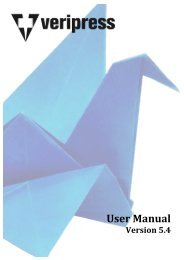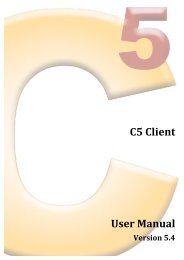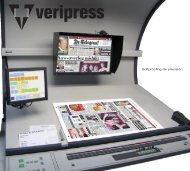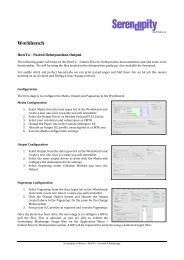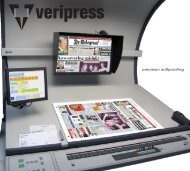Version 5.3.02 - Serendipity Software
Version 5.3.02 - Serendipity Software
Version 5.3.02 - Serendipity Software
You also want an ePaper? Increase the reach of your titles
YUMPU automatically turns print PDFs into web optimized ePapers that Google loves.
Displays <br />
The Displays application uses a supported Spectrophotometer to calibrate and create an ICC profile for a selected <br />
monitor or light booth. Suitable graphics monitors can be calibrated to match a chosen print gamut, allowing colour <br />
accurate softproofing of print material and can be verified at any time to ensure correct colour output. <br />
Creation of a profile is very simple, requiring a supported instrument and a few minutes of time. The <br />
Spectrophotometer is placed on the screen to be calibrated. A series of adjustments are made to the screen gamma, <br />
white point and brightness (if available). Measurements are taken, from which an ICC profile is created and saved in <br />
Veripress and the operating system as the native display ICC profile. <br />
Note: The Displays application creates a profile for use with the Match ICC profile assigned to the monitor in Server <br />
Settings. Ensure the correct match profile is set before creating the monitor profile (see the Server Settings – Colour <br />
Management section for details). <br />
The Displays interface comprises of a function list (left) and a multi-‐purpose display area (right) that will change <br />
depending on the function selected. <br />
The function list is made up of the following selectable items: <br />
• Calibration – Lists each connected display available for calibration. <br />
• Calcheck – Lists each connected display available to calcheck. <br />
• History – Lists the calcheck history (reference only) of each connected display. <br />
• Ambient – Measure the ambient and white point of the light source. <br />
• Light Booth – Appears only when a light booth is connected and will list each connected <br />
device. <br />
Calibration <br />
The Calibration function displays currently connected monitors and their calibration status. <br />
By clicking on the Calibration header, each connected monitor shows the following details: <br />
• The name of the Display, viewable screen dimensions in mm x mm, and its <br />
identification number (in a multi-‐display environment). <br />
• Pixels (width/height). <br />
• Resolution (DPI). <br />
• ICC profile. <br />
• Calcheck Status. <br />
• Last Calibrated (time). <br />
• Calibration Expires (time period). <br />
• Hardware Calibration (supported or not for the particular display). <br />
By clicking on the Display name, calibration options and settings available for the monitor are shown. These include: <br />
• Brightness – Only available if hardware calibration is supported and selected for the monitor (see below). <br />
Choose to set the brightness level in either: <br />
o Candela – Brightness in cd/m 2 <br />
o Set the level from 0-‐100% <br />
o Measure – Click to use a connected <br />
Spectrophotometer to measure and display the <br />
brightness (cd/m 2) and white point (K) of the <br />
monitor. Follow any onscreen instructions for the <br />
selected instrument. The reading is constantly <br />
updated, allowing the user to manually adjust the <br />
brightness using the monitor’s own controls. This option is only available if the Use <strong>Software</strong> <br />
Calibration option is selected or is the only mode available (see below). <br />
• White Point – Select the white point temperature for the monitor. Choose from: <br />
<strong>Serendipity</strong> <strong>Software</strong> -‐ Veripress User Manual – <strong>Version</strong> <strong>5.3.02</strong> <br />
78



